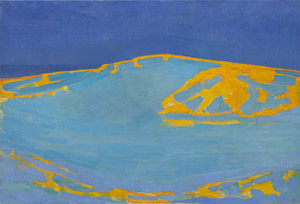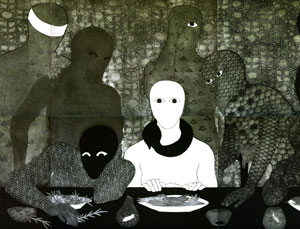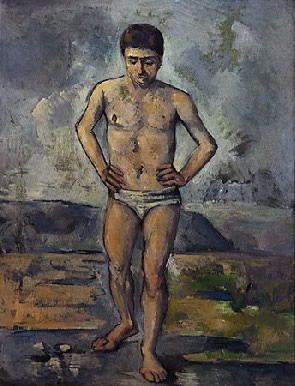5.14.25 — The Big Picture
Otobong Nkanga invites you to approach her work in stages, and each stage opens onto larger and larger vistas. She calls it Cadence and speaks of it as the cadences of life—but human life, she adds, is only a fraction of the cosmic picture. I want to say a negligible fraction, but it is the part that humans feel most keenly.
In fact, the big picture looks indelibly marked by humanity. Whether that is a good thing is hard to say, but it is impressive all the same. On commission for the outsized and unruly atrium at MoMA, she does her best to run out of space, through June 8. And I work this together with earlier reports on mixed media taking on painting, sound art, and installation as a longer review and my latest upload. Julius Eastman, Glenn Ligon, and Nour Mobarak also just happen to take on issues of race and personal identity as well.
There is no right way to tame the atrium, the worst element of MoMA’s 2004 expansion, because no one, however adept, really can. I still think of it as little more than a shopping mall whose chain stores have gone out of business. Recent installations, though, have refused to get lost in its waste of space. They can let classic works, like Rhapsody by Jennifer Bartlett or New Image painting by Susan Rothenberg, run its full length. They can play on the furniture and function of the museum itself, like Amanda Williams—or recreate city streets and fire escapes as a gathering space, like Adam Pendleton. Nkanga works on a still larger tapestry, literally and figuratively.
A single image sets the scene, draping down across an entire wall of the atrium, but not the center wall. Is that to keep it from dominating the rest? Rope sculpture hangs down from above, too, coming to rest on shiny black sculpture of craggy rocks. Bulges punctuate the rope, like bulges in wire sculpture for Ruth Asawa. Downright small work has the remaining walls—relief paintings, with caked surfaces like dried earth. They are largely monochrome, even when interrupted by unreadable text.
Or is it merely to give the tapestry the atrium’s largest wall. (Who knew that the walls differ in size?) It is a landscape, but not a familiar one from planet earth. At bottom, shimmering white curves outline what could be plants or waves. At top, orange fills the sky in bursts, like galaxies without stars or bombs bursting in air without the patriotism. About halfway up, a couple seen from behind contemplates the scene. They seem to take it all in without a care for the damage that people can exact.
Then, too, Nkanga might have chosen that wall because you cannot see it until have entered. Rounding the corner from outside, you first encounter the sculpture and a tempting glimpse of the small paintings. Once inside, you can stumble around fairly uncluttered space. It is officially the Marron Family atrium, and no doubt “family” refers to the donors, but parents do let their kids run about. You have already accumulated a reserve of impressions, varying in size, texture, and color. And then you can turn to discover the cosmos.
You can hear it as well, although not the explosions. A chorus chants something ethereal, while a single male voice repeats just one cadence. Nkanga hardly minds if you cannot understand a word of it. She is not spelling things out. Born in Nigeria, she works in Belgium, but nothing I could see alludes directly to her heritage, and the couple in the tapestry is probably white. And I do wish the work cohered and the text made sense, but everything seems to emanate from the landscape.
Read more, now in a feature-length article on this site.


